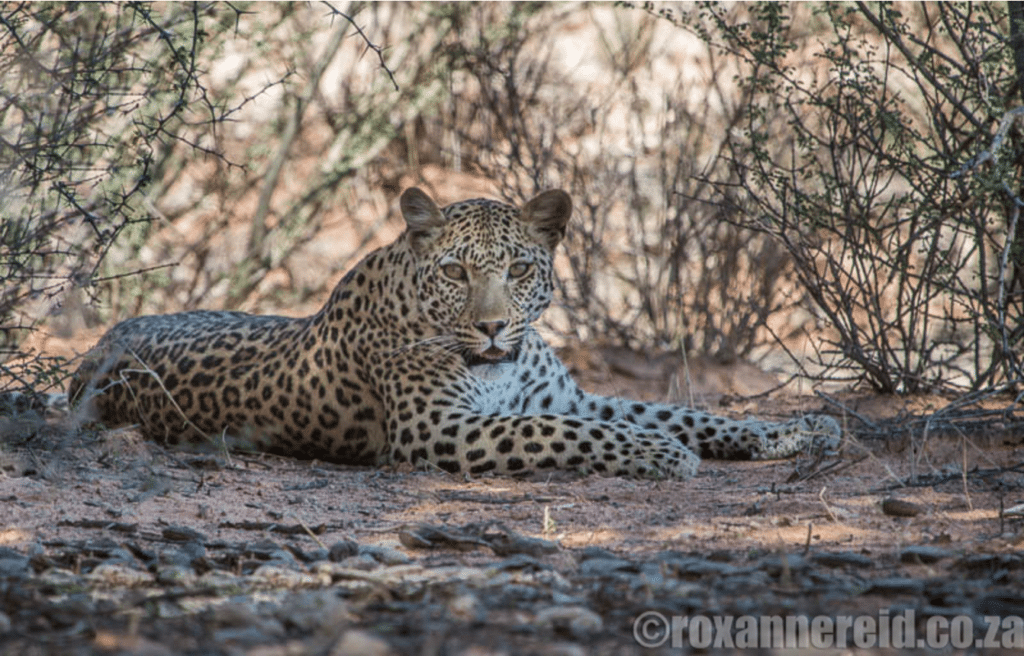As any regular visitor to the Kgalagadi Transfrontier Park will know, it can be dry or green, hot enough to fry your brain or cold enough to freeze your blood, but it’s always rewarding. Take as an example the entertainment put on by the lions, the leopard and the camelthorn tree in the Auob riverbed when we visited in March 2015.
We’d had a feast of electric storms, but no more than a few spits of rain. We’d seen meerkat and honey badger, a jamboree of whitebacked vultures kickboxing their way around a gemsbok kill on the dunes, a cheetah on a springbok kill and so many lions sleeping that the mere sight of them got us yawning too.
But we were walloped awake by a sphinx-like leopard in the shade of a grey camelthorn tree about a kilometre north of Auchterlonie waterhole. Amazingly in this increasingly popular park, we had her to ourselves for nearly 20 minutes before other cars arrived, time enough to notice a springbok kill in a high branch above us.
From the leopard identification book compiled by the wonderful Kgalagadi Leopard Project, we knew she was Warona, daughter of the Auchterlonie Female. She was born in October 2012 and is frequently seen along the Auob between Munro and Gemsbokplein waterholes.
We watched her morning and afternoon for two days. She mostly followed the shade or hid behind a thorn bush when too many cars were coming and going and making noise.
On the third morning, I was certain she’d have gone; there wasn’t much meat left on the carcass and it was starting to smell too skanky for anyone but scavengers to find appealing.
Sure enough, she was nowhere to be seen. But we did find a family of five lions walking towards Auchterlonie waterhole, mom, dad and three almost full-grown cubs, two of them with the first sprouting of manes. They drank at the waterhole and lay in the shade for a bit before walking further north.
Soon they were sniffing the air. Lions are ardent scavengers so the springbok kill must have seemed enticing.
When they arrived at the grey camelthorn tree where the last remnants of the leopard kill were still dangling, there was much excitement, all eyes on the prize. Big Daddy tried to climb the tree but quickly realised he was too heavy.
The cubs were very vocal, moaning in frustration before one of them – let’s call her TopCat – took a leap into the tree and climbed to the branch with the kill. Ungainly, undignified, she inched forward onto the branch, a few ominous creaks here and there. We were so close to the action that if the branch had broken, both branch and lion would have catapulted onto the bakkie next to us.
Springbok horns are tricky things and the kill was tightly wedged, its ribcage and the scraps of one leg on one side of the branch, its head and horns on the other. TopCat gave a few tugs, muscles straining. Frustrated, she started eating in the tree, bones crunching loudly.
By now, a second cub – we’ll call it Sidekick – had climbed the trunk, his nose millimetres from the back toes of his munching sister. He moaned in frustration, but TopCat just kept crunching and growling to warn him off. Eventually Sidekick reversed out of the tree again, but continued to watch with keen interest from the ground.
After about 10 minutes TopCat tried again to pry the kill loose, succeeding instead in unbalancing herself. Claws scrabbled furiously at the bark as she tried to save herself.
Her front paws found a branch and latched on, the rest of her body stretched long like a domestic cat’s, back paws still about three feet from the ground.
The lion hung there for 8 or 10 seconds, uncertain how to continue, then admitted defeat and dropped heavily into a thorn bush.
Now Sidekick had his chance and was up the tree in a flash, following the same passage to the kill, but much faster than his trailblazing sister had done. He eased even further out on the branch where the kill was. Creak, crack!
Part of a branch fell away and the lion stopped, leg muscles tensed. He crept forward again, got the carcass in his teeth and gave a few good pulls. The head with horns came tumbling out of the tree, but no one noticed.
Sidekick clamped the ribcage in his jaws. We thought he was going to fall backwards through the thorns and branches as TopCat had done, but he’d learnt from his sibling’s mistakes and reversed like a champion.
We could see his muscles tensing as he backed down, both back paws on one spot in the fork of the grey camelthorn, then back a little more. Slowly, slowly.
The instant he reached ground the others bounded up hopefully but he growled fiercely and they backed off. While he was enjoying the ribcage Stage Left, one of the others at last came round the front of the tree, discovered the head and carried it off Stage Right. Two young lions chomping happily.
This is why I love lion cubs and teenagers. They’re still keen on action and adventure so they’re great fun to watch, whereas mom and dad sleep passively. We watched the youngsters for almost two hours and there wasn’t a dull moment. We barely noticed the 39-degree heat.
It’s sightings like these tree-climbing lions of Kgalagadi that all of us Kalahari addicts live for in the bush.
—
This article first appeared on Roxanne Reid’s blog.

